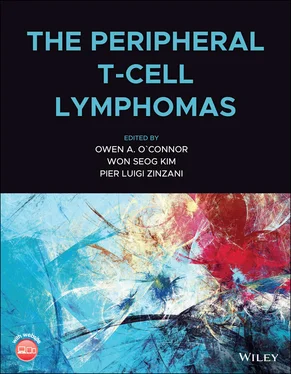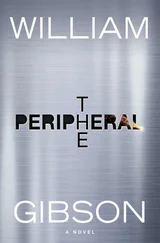Epigenetic changes generally are the result of two processes: (i) DNA methylation (DNA global hypomethylation and promoter‐localized hypermethylation) and (ii) histone modifications. The proteins responsible for the alterations characteristic of the cancer epigenome are the enzymes that catalyze DNA methylation, the proteins that bind methylated DNA at promoters and contribute to transcriptional silencing, and the chromatin modifier enzymes that catalyze histone acetylation, deacetylation, methylation, and demethylation.
Adding another layer of complexity, not only can gene transcription be altered within the abnormal cell by abnormal changes in these processes, cancers can harbor specific mutations of key epigenetic controlling genes. For example, the methylation of cytosine residues to 5‐methylcytosine (5mC) is mediated by DNA methyltransferases (DNMTs), and gain‐of‐function mutations of DNMT3A have been identified frequently in hematologic malignancies. A good example of this might be Sézary syndrome [2–5]. Other such mutations discovered within TCLs include IDH2, TET2, MLL2, KMT2A, KDM6A, CREBBP , and EP300 genes [3, 6–10]. Thus, TCLs appear to be a group of diseases with significant epigenetic vulnerabilities that can be exploited in rational therapeutic approaches.
The best understood, and currently the most clinically relevant, of these derangements involves histone modification mediated by HDAC proteins. HDACs are classified by their homology to yeast HDACs. To date, 18 HDACs have been described, of which 11 are zinc‐dependent metalloproteinases belonging to classes I, II, and IV. Specific HDAC enzymes in these classes constitute the focus of most HDAC research, which, usually in conjunction with other co‐repressors, deacetylate the terminal amino‐moieties of lysine on the histone protein [11]. The acetylation status of histone depends on the balance between deacetylase activity and histone acetyltransferase (HAT) activity in the cell. Deacetylation results in a relatively closed chromatin conformation that leads to repressed transcription [11]. Thus, HDAC inhibitors (HDACi) are generally considered to be transcriptional activators [12]. However, gene expression profiling has demonstrated that as many genes may be repressed as de‐repressed after exposure to an HDACi. This is likely to be a consequence of the direct and indirect effects of these drugs on other transcriptional regulators and cell signaling pathways, and/or the dynamic and complex interrelations between chromatin remodeling and regulated gene transcription [13, 14].
HDACi are currently classified according to their chemical structure, and each agent varies in its ability to inhibit individual HDACs ( Table 3.1). HDACi share a common pharmacophore containing a cap, connecting unit, linker, and a zinc‐binding group that chelates the cation in the catalytic domain of the target HDAC [15]. Examples of the pan‐deacetylase inhibitors include vorinostat (suberoylanilide hydroxamic acid, SAHA), panobinostat (LBH589), chidamide, and trichostatin A, which inhibit class I, II, and IV HDACs, while valproate, entinostat (MS‐275) and romidepsin (depsipeptide, FK228) are considered relatively class I‐specific, while tubacin is considered an HDAC6‐specific inhibitor ( Table 3.1). These specificities are relative, as, in vivo, the concentration of these drugs achieved is typically orders of magnitude above the concentration showing to inhibit the enzyme in cell‐free systems. These supratherapeutic concentrations are likely to increase the spectrum of individual HDAC enzymes inhibited by any given HDAC inhibitor. Recent efforts in drug development have also focused on discretely targeting specific HDACs. HDAC6 for example, is predominantly [16, 17] but not exclusively [13] localized to the cytoplasm. Inhibition of HDAC6 is associated with very specific effects, including those on cell motility, the proteasome and aggresome pathways, which are considered by some investigators to be responsible for much of the cytotoxicity of the HDACi in general. This is one example of how different HDACi may vary in their HDAC selectivity, as the pan‐HDACi include HDAC6 among their targets, while the “class 1‐selective” HDACi (such as romidepsin) do not. Such differences may provide a rationale for the development of novel, highly HDAC‐specific agents.
Selective inhibition of HDAC3 has also emerged as a novel mechanism for therapy in B‐cell lymphomas that express the CREBBP mutation. CREBBP codes for the CREB binding protein which catalyzes histone acetylation. CREBBP mutations are highly recurrent in B‐cell lymphomas and either inactivate (i.e. loss of function) its histone acetyltransferase domain or truncate the protein. CREBBP plays a critical role in supporting p53 dependent tumor suppressor functions and is inhibited by viral basic leucine zipper transcription factor HBZ found in many lymphomas [18]. CREBBP mutations are direct targets of the BCL6/HDAC3 onco‐repressor complex and HDAC3 selective inhibitors reverse CREBBP mutant aberrant epigenetic programming. By restoring the function of these genes, HDAC3 inhibitors restore the ability of tumor infiltrating lymphocytes to kill diffuse large B‐cell lymphoma (DLBCL) cells in an MHC class I‐ and II‐dependent manner [19].
For now, it is more convenient to group the HDACi in commercial development into the pan‐HDACi and those that are relatively more class 1‐specific. It is important to recognize that while some HDACi may be more class specific, these drugs, as noted above, typically achieve high micromolar concentrations in the plasma, and likely inhibit a broader array of HDAC in the clinical setting.
Table 3.1Classes of histone deacetylase inhibitor (HDACi).
| HDACi class |
HDAC specificity |
| HDAC Cellular Distribution |
Nuclear |
Nuclear, Cytoplasmic |
Cytoplasmic |
Nuclear |
| HDAC Class |
I |
IIa |
IIb |
IV |
| HDAC |
1 |
2 |
3 |
8 |
4 |
5 |
7 |
9 |
6 |
10 |
11 |
| Short chain fatty acids |
Butyrate |
|
|
|
|
|
|
|
|
|
|
|
|
Valproate |
|
|
|
|
|
|
|
|
|
|
|
| Hydroxamic acid derivative |
Tubacin |
|
|
|
|
|
|
|
|
|
|
|
|
Belinostat (PXD101) |
|
|
|
|
|
|
|
|
|
|
|
|
Panobinostat (LBH589) |
|
|
|
|
|
|
|
|
|
|
|
|
Trichostatin A |
|
|
|
|
|
|
|
|
|
|
|
|
Vorinostat (suberoylanilide hydroxamic acid, SAHA) |
|
|
|
|
|
|
|
|
|
|
|
| Benzamide |
Mocetinostat (MGCD0103) |
|
|
|
|
|
|
|
|
|
|
|
|
Etinostat (MS‐275) |
|
|
|
|
|
|
|
|
|
|
|
| Cyclic tetrapeptide |
Romidepsin (depsipeptide) |
|
|
|
|
|
|
|
|
|
|
|
HDACi induce a plethora of molecular and extracellular effects that alone or in combination, result in potent anti‐cancer activities [1]. The drug targets, HDACs, are diverse and exhibit different substrate specificities and biological functions. Despite the rapid expansion of literature in this area, we remain uncertain of the mechanistic hierarchy of the HDACi. For example, while it is clear that HDACi induce apoptosis associated with altered transcription of proteins involved in the intrinsic and extrinsic pathways, other mechanisms are in play, such as those relating to the aggresome/proteasome system. Through hyperacetylation of histone and non‐histone targets, HDACi can induce quite diverse effects on cellular function. These include: (i) altering immune responses through effects on the host and/or target cells; (ii) inducing permanent (i.e. senescence) or temporary (quiescence) cell‐cycle arrest, usually at the G1/S transition; (iii) inhibiting angiogenesis, and (iv) inducing apoptosis and autophagy [20–24]. HDACi not only induce injury to the cell, they also modulate its ability to respond to stressful stimuli. Moreover, it is important to appreciate that the anti‐tumor effect of these drugs is due to targeting not only the tumor cell itself, but also the tumor microenvironment and the immune milieu.
Читать дальше












